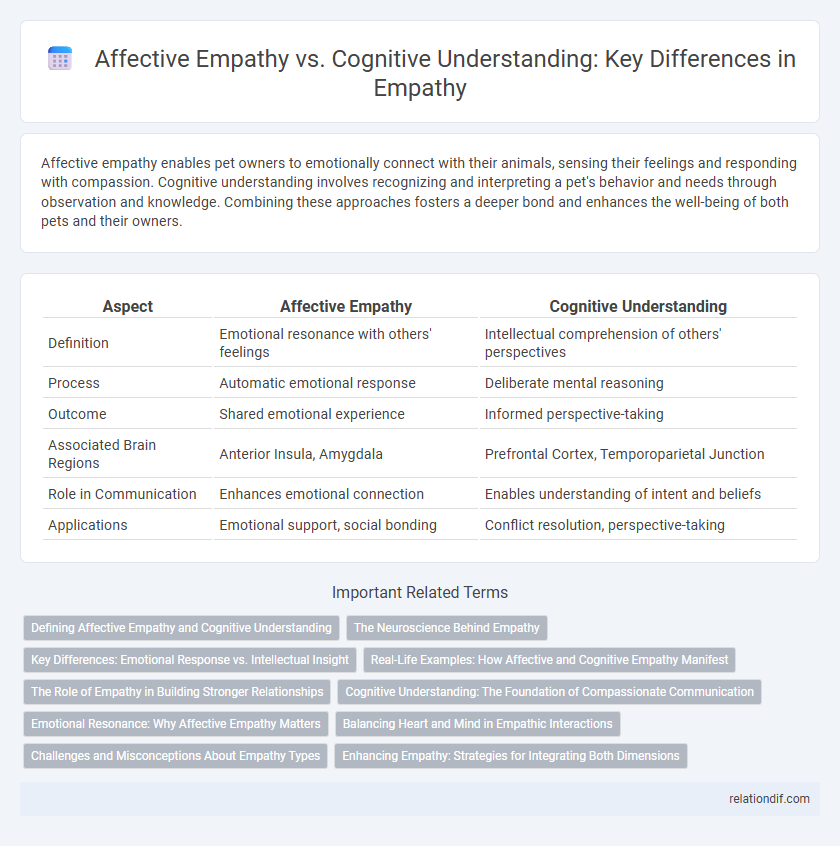Affective empathy enables pet owners to emotionally connect with their animals, sensing their feelings and responding with compassion. Cognitive understanding involves recognizing and interpreting a pet's behavior and needs through observation and knowledge. Combining these approaches fosters a deeper bond and enhances the well-being of both pets and their owners.
Table of Comparison
| Aspect | Affective Empathy | Cognitive Understanding |
|---|---|---|
| Definition | Emotional resonance with others' feelings | Intellectual comprehension of others' perspectives |
| Process | Automatic emotional response | Deliberate mental reasoning |
| Outcome | Shared emotional experience | Informed perspective-taking |
| Associated Brain Regions | Anterior Insula, Amygdala | Prefrontal Cortex, Temporoparietal Junction |
| Role in Communication | Enhances emotional connection | Enables understanding of intent and beliefs |
| Applications | Emotional support, social bonding | Conflict resolution, perspective-taking |
Defining Affective Empathy and Cognitive Understanding
Affective empathy involves the ability to share and respond to another person's emotional experiences, allowing individuals to feel what others feel on an emotional level. Cognitive understanding, also known as cognitive empathy, refers to the capacity to intellectually comprehend and accurately interpret another person's emotions and perspectives without necessarily sharing those feelings. Differentiating these concepts highlights how affective empathy drives emotional connection, while cognitive understanding enables perspective-taking and informed social interactions.
The Neuroscience Behind Empathy
Affective empathy engages brain regions such as the anterior insula and anterior cingulate cortex, which process emotional experiences and enable individuals to share others' feelings physically and emotionally. Cognitive understanding, or cognitive empathy, predominantly involves the medial prefrontal cortex and temporoparietal junction, areas responsible for perspective-taking and theory of mind, allowing for the intellectual recognition of others' emotions. Neuroscientific studies using fMRI reveal distinct neural networks for these empathy types, highlighting the brain's dual mechanisms in processing emotional resonance versus cognitive appraisal.
Key Differences: Emotional Response vs. Intellectual Insight
Affective empathy involves sharing and experiencing another person's emotions, creating a direct emotional response that fosters deep connection. Cognitive understanding, on the other hand, refers to the intellectual ability to recognize and comprehend another's emotional state without necessarily feeling it. The key difference lies in emotional resonance versus analytical awareness, which shapes how individuals respond in social interactions and emotional support.
Real-Life Examples: How Affective and Cognitive Empathy Manifest
Affective empathy is evident when a person feels genuine sorrow seeing a friend mourn a loss, sharing their emotional pain without needing explanation. Cognitive empathy appears when a manager anticipates an employee's stress during tight deadlines by logically understanding their perspective and offering targeted support. Real-life examples highlight how affective empathy drives emotional connection, while cognitive empathy enables strategic social interactions.
The Role of Empathy in Building Stronger Relationships
Affective empathy, involving the ability to share and respond to others' emotions, creates immediate emotional connections that foster trust and intimacy in relationships. Cognitive empathy, which is the capacity to understand another's perspective and thoughts, enables effective communication and conflict resolution, strengthening relational bonds. Together, these dimensions of empathy enhance emotional attunement and mutual respect, crucial for building and sustaining stronger, more resilient relationships.
Cognitive Understanding: The Foundation of Compassionate Communication
Cognitive understanding involves the ability to intellectually grasp another person's perspective, enabling precise interpretation of their thoughts and feelings. This form of empathy underpins compassionate communication by fostering clear, respectful dialogue and reducing misunderstandings. Mastery of cognitive understanding enhances conflict resolution and promotes meaningful connections in both personal and professional relationships.
Emotional Resonance: Why Affective Empathy Matters
Affective empathy involves the emotional resonance that allows individuals to genuinely feel and share the emotions of others, creating a deep, authentic connection. This emotional mirroring is essential for fostering compassion, trust, and social bonding. Unlike cognitive understanding, which is rooted in intellectual perspective-taking, affective empathy drives motivational processes crucial for prosocial behavior and emotional support.
Balancing Heart and Mind in Empathic Interactions
Affective empathy involves sharing and resonating with another person's emotions, while cognitive understanding focuses on recognizing and interpreting those emotions through a mental framework. Balancing affective empathy and cognitive understanding enhances empathic interactions by combining emotional connection with rational insight, leading to more effective communication and support. Integrating both heart and mind allows for compassionate responses that are emotionally attuned yet thoughtfully considered.
Challenges and Misconceptions About Empathy Types
Affective empathy involves sharing another person's emotions, while cognitive understanding focuses on intellectually grasping their perspective. Challenges arise when affective empathy leads to emotional overload or bias, and cognitive empathy results in detachment or lack of genuine connection. Misconceptions often confuse these types as being mutually exclusive, overlooking the importance of balancing emotional resonance with thoughtful insight.
Enhancing Empathy: Strategies for Integrating Both Dimensions
Enhancing empathy involves integrating affective empathy, which is the capacity to emotionally resonate with others, and cognitive understanding, the ability to intellectually comprehend their perspectives. Effective strategies include active listening, perspective-taking exercises, and emotional regulation techniques to balance feeling and understanding. Combining these approaches fosters deeper interpersonal connections and improved social communication.
Affective Empathy vs Cognitive Understanding Infographic

 relationdif.com
relationdif.com